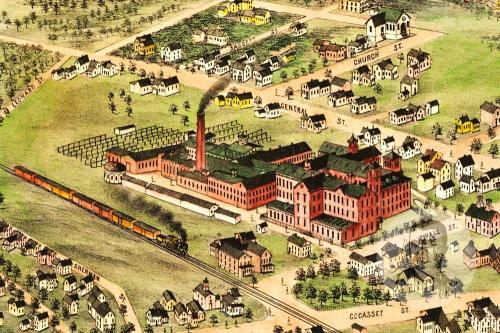While browsing through maps, I happened upon something interesting in the Foxborough map. Towards the left side of the map you see a large red building. Here we can see it again in detail:

This building was the Union Straw Works, the biggest straw hat factory in the US. My attention was caught by the little rack-like items in the back of the building. WHAT ARE THEY? My first thought, as a Dutch citizen, was: ahh, there are their bike racks. Obviously though, they are not bike racks. How about places to hitch up your horse? But the map was drawn in 1879 and most of the factory workers would live local, they wouldn’t come by horse. So that makes no sense either.
Let’s look at it from a different angle:

A drawing from the same date, but the structure looks very different, almost spiral-like.
(And to make it even more interesting: here is a map from the same date and the same place, the building looks similar and the structure looks similar, but the town layout and streets look completely different! Confusing.)
Straw hats were a real fashion staple in the 19th century. They were first imported from Europe but imported goods were expensive. When fashion for straw hats grew, many American companies started to make straw hats, culminating in this big factory in Foxborough, at one time the largest straw hat factory in the US.

Some of the straw hats from the 19th century.
Straw hats were tied to some strict rules though: you weren’t supposed to wear them after summer. And when some men tried to wear them anyway, actual straw hat riots broke out in New York.
So, now for my theory on the racks behind the building. I think they could be one of two things: either this was where straw was unloaded from farmer’s carts and set upright to dry out until it was used, or it was a place to dry out the hats themselves after they were finished. To make a straw hat, after the braiding and shaping the hat was made wet so as to stiffen and hold its shape better. (source) The drying afterwards might have taken place outside.
What do you think?
If you want to learn more about Foxborough’s history, start here.
I want to thank our monthly sponsor Ted’s Vintage Maps, for their support for this website! Don’t forget to check out their amazing historical maps.
 Hi! My name is Geerte, I'm a researcher of Nineteenth century history from the Netherlands. This blog is where I write about my favourite subject. Feel free to browse around!
Hi! My name is Geerte, I'm a researcher of Nineteenth century history from the Netherlands. This blog is where I write about my favourite subject. Feel free to browse around!
Leave a Reply